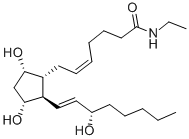ProstaglandinF2αEthanolamideMaxSpec?Standard , ≥98% , 353787-70-9
Synonym(s):
Dinoprost ethanolamide;N-(2-Hydroxyethyl)-9α,11α,15S-trihydroxy-prosta-5Z,13E-dien-1-amide
| Pack Size | Price | Stock | Quantity |
| 100ug | RMB1216.00 | In Stock |
|
| others | Enquire |
PRODUCT Properties
| Flash point: | 14 °C |
| storage temp. | −20°C |
| solubility | DMF: Miscible; DMSO: 10 mg/ml; Ethanol: Miscible; PBS (pH 7.2): 10 mg/ml |
Description and Uses
Prostaglandin F2α ethanolamide (PGF2α-EA) is produced by COX-2 metabolism of the endogenous cannabinoid, arachidonoyl ethanolamide (AEA), found in brain, liver, and other mammalian tissues. AEA can be metabolized directly by the sequential action of COX-2 and specific PG synthases to produce ethanolamide congeners of the classical PGs. PGF2α-EA has also been reported to be biosynthesized by this mechanism when AEA was infused into the lung and liver of living mice. PGF2α-EA is a potent dilator (EC50 = 58 nM) of the cat iris sphincter, which is a model system for testing potential intraocular hypotensive agents.
Prostaglandin F2α ethanolamide (Prostamide F2α) is an ethanolamide-like G protein-coupled receptor. Prostaglandin F2α is also a luteinizing hormone in sheep and may be a nociceptive mediator in the spinal cord[1][2][3].
Safety
| Symbol(GHS) |   GHS02,GHS07 |
| Signal word | Danger |
| Hazard statements | H225-H319 |
| Precautionary statements | P210-P305+P351+P338 |
| Hazard Codes | F,Xi |
| Risk Statements | 11-36/37/38 |
| Safety Statements | 7-16-26-36 |
| RIDADR | UN 1170 3/PG 2 |
| WGK Germany | 1 |


